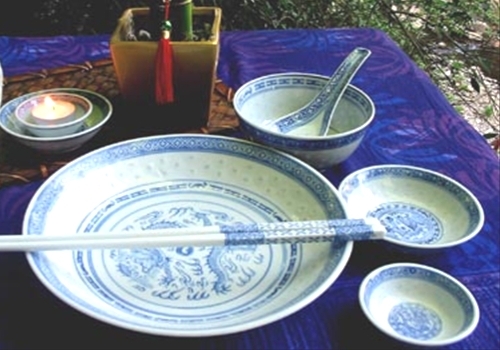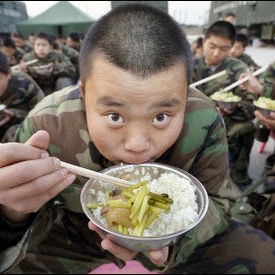I struggled with chopsticks for decades before I met an Asian friend who took pity on me and revealed the secrets of the ‘cutlery’ used by the majority of the diners in the world. Now you, too, can choose any Asian eatery you like without worrying whether they’ll deign to let a Western heathen use a knife and fork!
 A classic Chinese diner table setting: Always includes a plate, a bowl and some
A classic Chinese diner table setting: Always includes a plate, a bowl and some
smaller bowls for sauces and other condiments. Along with your chopsticks
you get a soup spoon…
If you’ve still got the training wheels on your chopsticks – like millions of Europeans and Americans (North and South) – a recent BuzzFeed offering will definitely help clear the fog surrounding these ancient and venerable eating utensils.
Watch and listen closely to the narration…
It’s as easy as one-two-three. At least that’s the contention of the narrator in the video showing how to hold and flex your chopsticks like a pro.
The secret – or the first one, anyway – is to hold the bottom stick still, firmly but not too tightly, with your thumb. Then, don’t move your thumb again after you’ve seated the stick. You’re supposed to hold the top stick ‘like a pencil’ and move it up and down to grasp and hold pieces of food. If you get good enough, you can even fashion a sort of scoop to spoon up stuff like rice and thin noodles. But using chopsticks as a spoon is frowned upon at traditional Asian tables.
In case you were wondering… Japanese chopsticks are used exactly like Chinese ones, with the added convenience that they are usually pointed on the grasping end – giving you the option of spearing pieces of food as well as grasping them! Of course, that’s froened upon in some Asian cultures…
Etiquette across Asian cultures
For more information on proper chopsticks etiquette, look here for Chinese rules, and here for Japanese rules. Korean etiquette is covered here. Thai dos and don’ts are here. Vietnamese rules are here.
Enjoy!
~ Maggie J.

